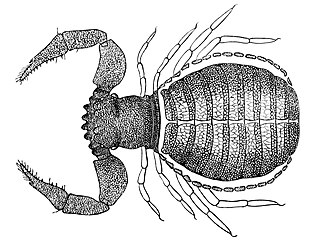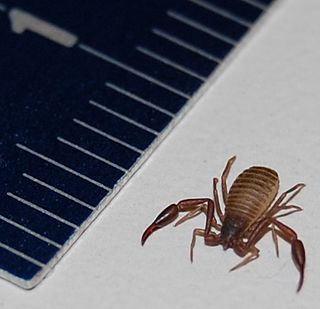
Feaella is a genus of pseudoscorpions in the family Feaellidae, first described by Edvard Ellingsen in 1906.
Menthidae is a family of pseudoscorpions, first described by Joseph Conrad Chamberlin in 1930.

Lechytia is a genus of pseudoscorpions in the subfamily Lechytiinae within the family Chthoniidae. It is the sole genus in its subfamily and contains 22 described species from many parts of the world.
Tridenchthonius is a genus of pseudoscorpions in the family Chthoniidae. There are about 16 described species in Tridenchthonius.

Chernetidae is a family of pseudoscorpions, first described by Anton Menge in 1855.
Cryptocheiridium is a genus of pseudoscorpions in the Cheiridiidae family. It was described in 1931 by American arachnologist Joseph Conrad Chamberlin.
Synsphyronus is a genus of pseudoscorpions in the Garypidae family. It was described in 1930 by American arachnologist Joseph Conrad Chamberlin. Its distribution is mainly in Australia, but also extends to New Zealand and New Caledonia.

Garypus is a genus of pseudoscorpions in the family Garypidae. It was described by German arachnologist Ludwig Carl Christian Koch in 1873. The species are found mainly in tropical and subtropical areas, where they occupy supralittoral and littoral zones in seashore habitats.

Cheliferidae is a family of pseudoscorpions in the order Pseudoscorpiones, first described by Antoine Risso in 1827.

Withiidae is a family of pseudoscorpions, first described by Joseph Conrad Chamberlin in 1931.
Lagynochthonius is a genus of pseudoscorpions in the family Chthoniidae. It was described in 1951 by Austrian arachnologist Max Beier.

Tyrannochthonius is a genus of pseudoscorpions in the family Chthoniidae. It was described in 1929 by American arachnologist Joseph Conrad Chamberlin.
Ideoblothrus is a genus of pseudoscorpions in the Syarinidae family. It was described in 1892 by Italian naturalist Luigi Balzan as a subgenus of Ideobisium.
Haplochernes is a genus of pseudoscorpions in the Chernetidae family. It was described in 1932 by Austrian arachnologist Max Beier.

Withius is a genus of pseudoscorpions in the Withiidae family. It was described in 1911 by English zoologist Harry Wallis Kew. The generic name Withius honours Danish arachnologist Carl Johannes With (1877–1923).
Solinus is a genus of pseudoscorpions in the Garypinidae family. It was described in 1930 by American arachnologist Joseph Conrad Chamberlin.
Euryolpium is a genus of pseudoscorpions in the Olpiidae family. It was described in 1938 by Russian zoologist Vladimir Redikorzev.

Olpium is a genus of pseudoscorpions in the Olpiidae family. It was described in 1873 by German arachnologist Ludwig Carl Christian Koch.
Paraliochthonius is a genus of pseudoscorpions in the Chthoniidae family. It was described in 1956 by Austrian arachnologist Max Beier.








